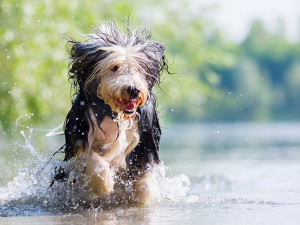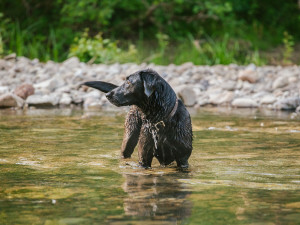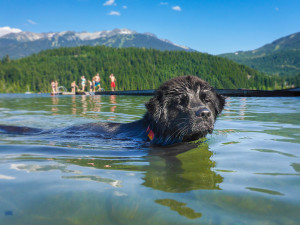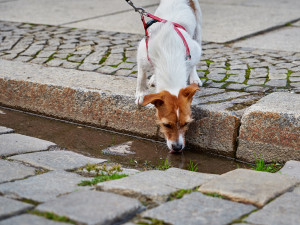How to Keep Your Dog Safe Wherever They’re Swimming This Summer
In the pool, a lake, a river, or the ocean.
Before you take your dog for a swim — whether they’re ready to dive into the ocean or just learning how to dip a paw into a baby pool — it’s vital that you learn about water safety.
There are plenty of subjects to read up on, from how to prepare your pup for the water to best safety practices to water-related medical issues to look out for. Prepare as much as possible so you can have peace of mind as you enjoy a beachside, poolside, or lakeside summer with your pup — and keep your swimming dog safe with these tips.
Prepare your pup for the water.
It’s easy to assume that all dogs love the water and are “natural-born swimmers,” but that’s not always the case. Some pups don’t like the water at all, and even those who do need to learn to swim. Give your dog time to acclimate by slowly easing them into the “deep end.” Throwing a stick or ball into the water is a good way to start; toss it progressively farther from shore or the shallow end of the pool until your dog seems comfortable with the activity.
Just as with humans, fear and fatigue can overwhelm canine swimmers of any level, so carefully monitor your pup around the water. Dog life jackets are a great idea if you and your dog plan to spend time on or near the water — say, on a boat. These flotation devices are a great safety precaution. Keep in mind that they require some getting used to, so it’s best to try one out on your dog on land or poolside, before the jacket is necessary.
How much do you spend on your pet per year?
Dog swimming safety
Near a swimming pool:
The best precaution is to prevent access to the water with a gate or sturdy pool cover.
Always supervise your dog’s water activity. Make sure they have a way to easily exit the pool (via steps or a ramp) and know how to use it.
At streams, rivers and lakes:
Make sure your dog’s wearing a properly fitted, quality canine life jacket.
It should go without saying, but keep your dog out of water that you wouldn’t swim in yourself. Beware of submerged objects (on which a dog could be impaled) and areas guarded by aggressive wildlife.
Don’t permit your dog to harass water fowl or local wildlife.
Monitor your dog. Swimming can be more tiring than running, so watch for signs of fatigue, including trembling, heavy panting, and/or swimming lower in the water or slower than usual.
At the ocean, where hazards are multiplied:
Don’t encourage your dog to venture far offshore. That means, don’t toss retriever toys and floats way out into the water. In the ocean, your dog is vulnerable to rough waves, riptides, and crosscurrents — any of which can be deadly.
If your dog is a toy breed or has short legs or a short muzzle, consider outfitting them with a life jacket, whether or not they intentionally go into the water.
Ocean water is bad for dogs, so do your best to keep them from drinking it. Large amounts of saltwater can sicken a dog, and may even prove fatal. Offer them fresh drinking water regularly.
Likewise, while your dog may love rolling in stinky fish and other things that wash up on the beach, they shouldn’t eat them. Dead fish and other marine life can contain deadly toxins.
Be aware of the sun. Overexposure can be as hazardous to dogs as it is to humans. Seek shade throughout the day and consider applying a canine-specific sunblock 30 minutes before time in the sun.
Water-related hazards
Water intoxication, also known as hyponatremia, can occur when dogs ingest large quantities of water very quickly. This can occur with dogs who repeatedly dive open-mouthed into the water to retrieve a ball or toy. It’s relatively rare but potentially fatal. Excessive water in the system causes electrolyte levels to drop, thinning blood plasma, leading to swelling of the brain and other organs.
As water has warmed in regions across the U.S., blue-green algae has become more of a concern in freshwater areas. This algae is incredibly toxic to dogs and can kill them within minutes. Learn how to recognize blue-green algae, and do not let your dog go anywhere near bodies of water where this algae is present, let alone swim in those areas.
“Swimmer’s tail,” or acute caudal myopathy (aka limber-tail syndrome), typically affects large-breed dogs, causing the dog’s tail to droop after too much time playing in the water. This type of overexertion can strain the muscles that keep a dog’s tail up and wagging. Along with tail limpness, the base of the tail is often stiff, and the dog may experience pain.
Hypothermia can affect dogs as well as humans. The general rule is that if you need to get out of the water because you’re getting cold, so does your dog.
Beware of fishing hooks. If your dog is swimming while you or others are fishing, be alert. Keep your dog away from your tackle box and whatever you may haul in to prevent them from swallowing fishhooks. And of course, don’t accidentally hook your dog; keep them at a safe distance while casting.
And on the subject of fish: salmon-type fish (salmon, trout, char, and others) found in waters along North America’s Pacific Northwest coast can carry a parasitic fluke (a type of worm) infected with a micro-organism called Neorickettsia helminthoeca. Dogs who eat these fish raw may come down with salmon poisoning disease (SPD), symptoms of which include fever, enlarged lymph nodes, and debilitating diarrhea and vomiting. Left untreated, SPD is fatal to 90 percent of the dogs who contract it. Contact your vet if you think your dog has ingested any of these fish.
Time spent in the water can be a blast for both you and your pup. Follow these simple practices to keep your dog safe and well.









